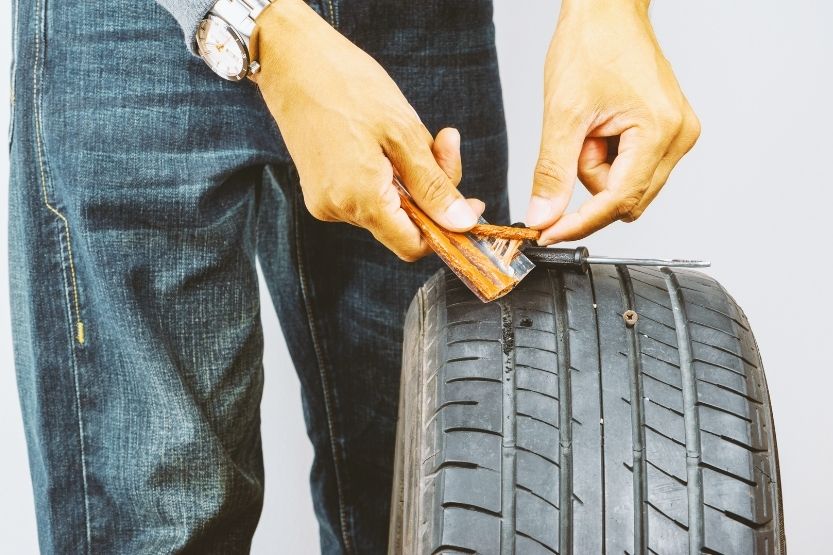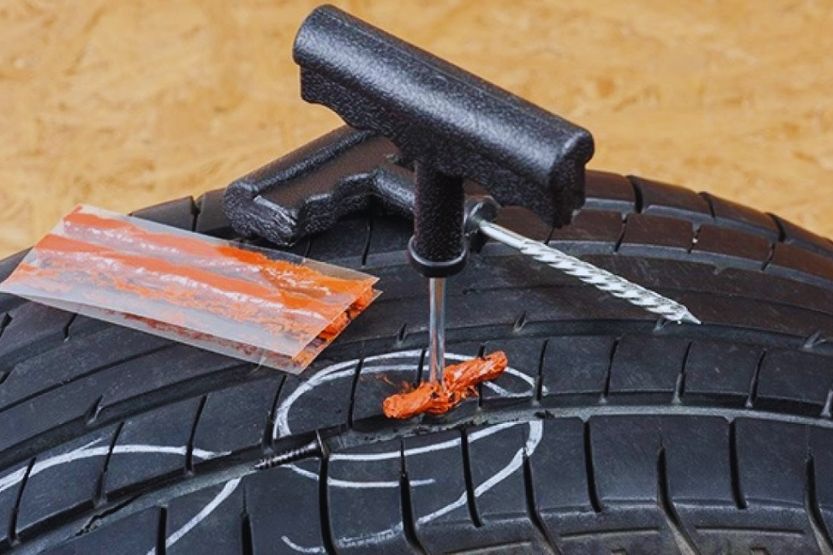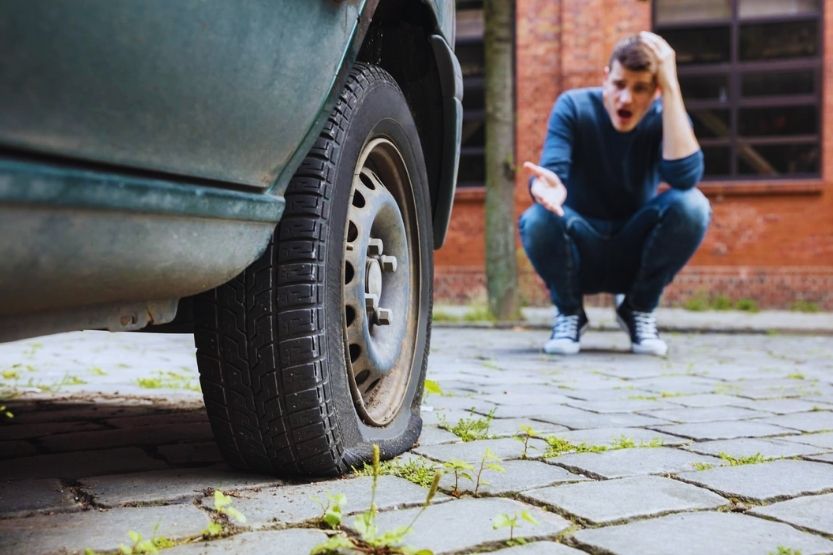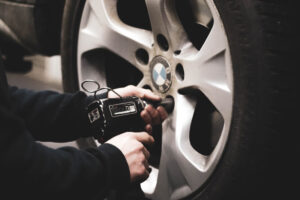With many car owners having tire problems, auto shops make huge money putting tire patches on their customers’ tires. If you know how to do it, you can save some money. How much does it cost to patch a tire?
On average, you can get a tire patch for less than $2.00. Additionally, a glob of bead sealer seals the patch, which costs less than $0.10. It will take around 15 minutes for a mechanic to patch a tire. If you consider that the standard mechanic’s pay is $120 per hour, you will be paying from $30 to $40 to patch a tire.
While it may seem costly, patching a tire is worth it if you consider your safety and that of your passengers. In addition, if you drive with a slightly damaged tire, you run the risk of causing permanent damage to the tire’s structure.
Read on to learn more about the cost of patching a tire and how a mechanic usually does this job.
How Much Does It Cost to Patch a Tire?

Average Cost of Patching a Tire
A tire patch usually costs less than $2.00 wholesale. You also need the glob of bead sealer, which seals the patch. Its price is no more than $0.10. A mechanic usually spends around 15 minutes patching a tire.
Tire shops usually pay their mechanics about $120 per hour. So, the average cost of patching a tire will run from $30 to $40, including patches and labor.
It may seem that patching a tire is a bit costly. However, it is worth it if you consider your safety and your passengers. When you drive your car with a punctured tire, you risk increasing its damage.
Heat Is Generated Inside an Underinflated Tire
There’s so much heat generated inside a tire that is running underinflated. That situation could cause more damage to the tire. It may even cause the tire sidewalls to break down in just a matter of seconds.
Never Patch a Tire More Than Once
If you have a correctly patched tire, you can still use your tire for seven to ten years. However, that depends on the location of the tire patch. While tire patches can last for many years, you should never patch a tire more than once. Patching a tire will reduce its speed rating. It can also cause blowouts.
So, tire plugs and patches are not permanent fixes. You should only drive a patched tire for as long as you need to get your car into a tire shop so you can have the tire permanently fixed.
How Much Does It Cost to Patch a Tire at Firestone?
Firestone Complete Auto Care offers the following services:
- Flat tire repair,
- Patching,
- Plugging, and more.
The cost to patch a tire at Firestone does not appear to be a specific price listing. But apparently, they will patch a tire for free, but only if you bought a tire and avail of their roadside hazard warranty.
Firestone offers a limited replacement warranty for new tires. But this warranty does not cover tire repairs. However, they also offer a roadside hazard warranty covering limited replacement and tire repairs.
How Much Does It Cost to Patch a Tire at Walmart?
Walmart has an Auto Care Center that repairs flat tires. Are you wondering how much it costs to patch a tire at Walmart?
The price of repairing a flat tubeless tire starts at $15.00 per tire. How long it would take them isn’t specified. But on average, it takes about one to five hours. If your flat tire is unrepairable, they also offer tire installation services. This ranges from $10.00 per tire.
How Much Does It Cost to Patch a Tire at Costco?
Costco Tire Centers offer flat tire repair services for members only. Costco’s installation fee which is $18.99 per tire includes the cost to patch a tire.
They will also repair tires that were installed somewhere else. But it will cost you $10.99, which cannot be refunded if your tire is irreparable.
How Much Does It Cost to Patch a Tire at Goodyear?
How much does it cost to patch a tire at Goodyear? It depends.
Is your tire a Goodyear, Dunlop, Kelly, or any other tire brand bought from a Goodyear Auto Service? If yes, they will do it for free as long as they can repair your tire without replacing it.
For other tire brands, however, repair costs start at $14.95. If they cannot repair your tire, they will try to offer you a fair price for a replacement.
How Much Does It Cost to Patch a Tire at Discount Tire?
If you want to know the cost to patch a tire at Discount Tire, you will be more than pleased to find out that it’s free. That’s right; Discount Tire offers flat tire repairs at no charge at all. It doesn’t even matter where you bought your tires.
They also offer free tire pressure check, as well as pumping up your tires complimentary.
Tire Patching Is Very Common
Patching tires is one of the most common services provided by tire service centers. A tire center will have at least three customers requesting tire patching services on an average day. So, tire service centers are making good money patching their customers’ tires.
Patching a tire is not that difficult. If you do it yourself, it will only cost you around $6.00. But if you take it to a tire center, it may cost you $30 to $40. Some would be lucky and spend only $10. It depends on where and how difficult it will be to apply the tire patch.
Why Tire Patches Cost This Much

Patching a Tire Yourself Is Cheaper
There are valid reasons why the cost of patching a tire yourself is considerably lower than the cost of having the tire center do it. If you do it yourself, you only worry about the cost of the tire patch.
Tire Patch Plus Labor Cost
When you ask a tire center to do it, you have to pay for the tire patch and the labor cost. In other words, you are also paying for the mechanic’s time aside from the cost of the tire patch. That’s why the cost to fix a tire at a tire shop is always higher.
Tire patches are for small tire punctures. If your tire has several small punctures, it may need tire sealant. Applying sealant to the punctures will entail additional costs. That can add another $15 to your bill at the tire shop.
A Mechanic Needs 15 Minutes to Patch a Tire
On average, it will take a mechanic around 15 minutes to patch a tire. It is the simplest job in a tire service center. While it is a straightforward task, it takes away time from a mechanic who could spend more demanding and high-paying car repair jobs.
This is why the average hourly rate of a good mechanic is $120 per hour. That is the charged rate even for simple tasks like tire patching. In other words, you are paying more for the service than for the patch itself.
The lesson: if you can do it correctly, you won’t spend more. That is why learning how to apply a tire patch should be one of your concerns – if you want to save money.
How to Patch a Tire
Steps
The procedure in applying a tire patch is not that difficult. You can do these steps at home, except for the tire balancing. It only involves eight steps. Here is the process:
- Remove the concerned tire from your car by unscrewing its nuts from the bolts of the wheel.
- Dismount the tire from the rim.
- Get a tire cleaner and clean the tire’s inner liner.
- Get a pointed object and clean the punctured hole in the tire.
- Place the tip of the patch through the punctured hole, and then pull it through until its base lays flat along the tire.
- Put enough bead sealer to the patch base.
- Once the patch is securely attached, remount the tire back on the rim.
- Balance the tire before mounting it on the wheel.
- Mount the tire back on its wheel.
Balance the Patched Tire Before Remounting
It is safer to balance the patched tire before remounting it on its wheel. This will ensure the even wear on the tire tread. It will also improve the handling and control of your car. Each time a fix is done on a tire, it is better to balance it before mounting it again.
Tire Balance Cost
Unfortunately, that will add to your repair cost. Balancing a tire usually costs around $13. If it needs a new PMS sensor, that will also increase your tire repair cost. However, some tire patching jobs can put off the purchase of a new tire later. So, you get that advantage by patching your tire.
A simple patch can cost you up to $45.00. If you need to get the tire rebalanced, that would cost you about $13.00. Getting new valve stems or a TPMS sensor can also saddle you with additional costs.
No Need for Tire Replacement
But getting your tires patched saves you from spending on a replacement tire. It is so effective that it feels like the tire was never punctured in the first place. It can be quite convenient when you need your tires done as soon as possible.
Of course, the average driver doesn’t normally have a tire machine at home. Suffice to say; you cannot do this method on your own. But the next procedure, tire plugging, can be carried out almost anywhere.
Again, how much does it cost to patch a tire? On average, you can have a tire puncture repair or tire patch for $30-$40. Some shops offer this service for free if you buy your tire from them.
How Do You Know If Your Tires Can Be Patched?

To find out if a mechanic can repair your tire, he will conduct certain tests. You can also conduct it yourself. Such tests would enable you to confirm whether your tire can be repaired or not.
Refrain from Driving with a Flat Tire
When you get a flat tire, you must remember to refrain from driving on it. If you drive on a flat tire for even a short period, it can sustain irreparable damage. Operating a tire without air will cause the vehicle’s weight to crush its innards and turn it to dust.
Verify the Cause of the Flat Tire
Next, you need to verify the cause of the flat tire. It is common to find a nail directly in the middle of the tire’s tread. You can easily spot one from a distance, but if you cannot see it, try to run your hand around the tread to find the nail’s location.
Tests to Confirm Whether the Tire Can Be Repaired with Tire Patch
The three tests that you can conduct are the following:
- Edge Test
- Length Test
- Tread Depth Test
Let’s discuss each of them:
1. Edge Test
A tire puncture within two inches of the sidewall is considered unrepairable. This means that neither you nor a tire shop will be unable to repair it.
It is against the law for a shop to repair tires with punctures close to the sidewall. This is because tire patches positioned close to the sidewall usually result in tire blowouts.
Measure the distance between the sidewall and the puncture by placing your thumb in the space between them. If the width of the puncture is a thumb or more away from the sidewall, it means the mechanic can still repair the tire. If not, you will need to get a new tire.
2. Length Test
The next thing you need to examine is the length of the tire puncture. Most of the time, nail punctures are only as wide as the nail that made them. If the puncture is only small, you may be able to patch the tire on your own.
But if the puncture’s length is 2 ½ inches or more, then you won’t be able to patch it. Unfortunately, a shop won’t do anything about it either. The mechanic cannot repair too large punctures because a patch cannot hold air over the puncture.
The inner tire liner won’t become fully sealed even using the largest patch available. So, you need to replace your tire.
Are you unsure of the results of edge and length tests? If yes, it is advisable to take your tire to a shop and let them look at it.
3. Tread Depth Test
You should also consider the remaining tread depth on the tire. Car mechanics use a tire tread bar to measure the remaining tread depth on tires. A tire patch cannot fix if the tread depth is less than 3/32 inches. Your tire is up for replacement.
Factors That Determine If a Tire Patch Is Enough
There are certain rules that you should follow concerning tire care and repair. If you want safe driving, you should follow these rules:
1. Cause of the Damage
Mechanics in tire service centers usually subject a punctured tire to certain tests to determine if they can still repair it. As they conduct these tests, they can tell if a tire can still be repaired or not. The most obvious examination they do is the visual test of the tire.
They do this to determine the cause of the flat or what caused the damage. Nails or screws puncturing the tread are very common. You can easily spot the hole by looking at the tire tread. If the hole is not visible, you can run your hands all over the tread to find it.
It is important that when you have a flat tire, you don’t drive on it. You will only make the damage more severe if you drive it, even just for a short distance. The car’s weight will destroy the tire’s inner structure that it is forced to carry.
2. Non-Repairable Tire Damage
If the tire has a puncture located within two inches of the sidewall, it can no longer be repaired. The only fix to your problem is to buy a new tire of the same size. Tire repair centers cannot repair such damaged tires since it is against the law.
You can attach tire patches on tires with punctures near the tire sidewall. However, due to the shifting nature of tires when they are being driven, the chances of blowouts are very high. So, it is still not advisable to patch a tire with holes near the tire sidewall.
Again, to determine whether a tire patch can repair the puncture, allow a mechanic to conduct the tests discussed above.
How to Do Tire Plugging?
Tire plugging is a simple solution that applies to different kinds of tire punctures. You can fix most tire punctures by plugging the tire by yourself.
Steps
Plugging a tire involves only a couple of simple steps:
- Push the plugging strip in with the T-handle as far as it can go.
- Quickly pull out the T-handle with all your strength. The tire is then plugged.
- Cut away the excess plugging strip.
Tire Patch Alternative
Many tire shops look down on tire plugging because they don’t think it fully seals the tire’s surface. But most independent shops do favor tire plugging as it keeps down prices for both the shop and its customers.
DIY or Ask an Independent Shop to Plug the Tires
You can do tire plugging by yourself in your driveway. But if you’re not sure that you can do this, you can always ask an independent shop to work on your tires. Most probably, they will offer both. But a tire plug will cost half as much as a full tire patch.
Should Tire Plugging Be Done at Home?
Hissing Sound After Tire Plugging
Although plugging tires is easy to do, there are some issues that you may run into. For instance, you’re hearing a slow hissing sound after plugging a tire. Unfortunately, tracing the source of the leak can be a headache.
Spray the Tire with Soap to Locate the Leak
You can try to spray down the whole tire with soap so that you can find the leak. But you might still fail to trace it. It can take you hours to resolve such a problem, even for expert mechanics.
Use the Spare Tire or Have It Repaired at a Tire Shop
If your car tire is completely flat, you could use your spare tire. Then, fix the flat one at home using a plugging kit. But if it still leaks even after plugging it, you should have it repaired at a tire shop.
Some shops have a machine that utilizes a crane-like object to lower a tire underwater. But even this device can sometimes fail, leaving mechanics dumbfounded. So, it is better to take your tire to a shop than to try locating and plugging a leak all by yourself.
Some mechanics may tell you that using double the amount of plugs can repair large gashes, but this is incorrect. If even a single plug cannot repair your tire, you should take it to a shop and see how much you can get back.
Repair Nail Puncture Located in the Middle of the Tire’s Tread Face
There are situations where a nail punctures the middle of the tire’s tread face. In which case, it is permissible to use a plug kit to repair the tire by yourself. Not only would it save you a few bucks, but it will also give you the chance to do a quick inspection of your car.
Conclusion: How Much Does It Cost to Patch a Tire?
The average price of a tire patch is usually less than $2.00. There’s an additional cost of less than $0.10 for the glob of bead that seals the tire patch. To patch a tire, a mechanic will usually spend around 15 minutes to complete it.
Considering the average hourly wage of a mechanic of about $120 per hour, you will be paying the car shop from $30 to $40 to patch your tire. While this may seem costly, considering the safety a good tire brings to you and your passengers is worth it.
Read next:



![Discount Tire Tire Rotation Cost [How Much Is It?] how much does a tire rotation cost at discount tire](https://roadsumo.com/wp-content/uploads/2022/04/how-much-does-a-tire-rotation-cost-at-Discount-Tire-150x150.jpg)
![Cost of Tire Rotation [Average Rotation Cost] Cost of Tire Rotation](https://roadsumo.com/wp-content/uploads/2021/10/cost-of-tire-rotation-150x150.jpg)
![How Much Is a Used Tire? Average Cost of Used Tires [Guide] how much is a used tire](https://roadsumo.com/wp-content/uploads/2022/03/how-much-is-a-used-tire-150x150.jpg)


![Read more about the article How to Use Fix-a-Flat [8 Easy Steps]](https://roadsumo.com/wp-content/uploads/2022/03/how-to-use-Fix-a-Flat-300x200.jpg)
